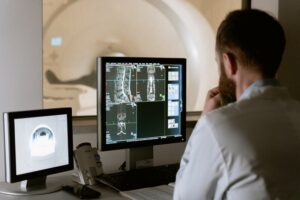What are Bone Spurs?
If you’ve had imaging done on your spine you may have been told that you have bone spurs. But what are bone spurs? How did you get them? And are they causing the pain in your neck or back?
What are Bone Spurs?
Bone spurs, medically known as osteophytes and enthesophytes, are locations where the bone has grown abnormally. Typically, they are projections from the typical shape of the bone. Contrary to the name bone “spur”, they are typically rounded, not sharp projections.
What Causes Bone Spurs?
Typically, bone spurs are the result of the body trying to adjust for a joints imbalance. Bone material is constantly being regenerated by the body, similar to fingernails. When a joint is imbalanced, bone material may grow abnormally in response to the imbalance. The initial joint imbalance may be caused by an injury, or overuse.
Arthritis is a condition characterized by joint irritation. Therefore, it’s not uncommon for arthritis and bone spurs to go hand in hand. In fact, the growth of bone spurs is quite common and develops as a normal part of aging.
Bone Spurs in the Spine
 As the body ages, the discs between each vertebra of the spine break down, become brittle, and can lose height. As a result, adjacent vertebrae may rub against one another as the body moves, bends, or twists. This irritation between the bones can result in the growth of a bone spur in that area.
As the body ages, the discs between each vertebra of the spine break down, become brittle, and can lose height. As a result, adjacent vertebrae may rub against one another as the body moves, bends, or twists. This irritation between the bones can result in the growth of a bone spur in that area.
Other soft tissues, like ligaments and tendons, can also change as they age. These changes can also result in the formation of bone spurs.
It’s common to see bone spurs during an x-ray or MRI of the neck or back.
Do Bone Spurs Cause Pain?
Bone spurs can exist with no symptoms. Therefore, you can have bone spurs, not know it, and not experience any pain as a result of their presence.
However, if the size and location of the bone spur is such that it irritates the nerves in or around the spine, it can cause pain. A bone spur rubbing on or irritating a nerve can cause the area to become inflamed.
Pain from bone spurs in the neck (cervical) region of the spine can cause a dull achy pain in the neck. The pain may radiate down one or both arms. There is also the potential for arm weakness or headaches at the back of the head.
When bone spurs exist in the lower back, they can cause pain in the area when standing or walking. This pain can radiate down the back of one or both thighs, and/or cause weakness in the legs. Pain is sometimes relieved by bending forward at the waist.
References:
